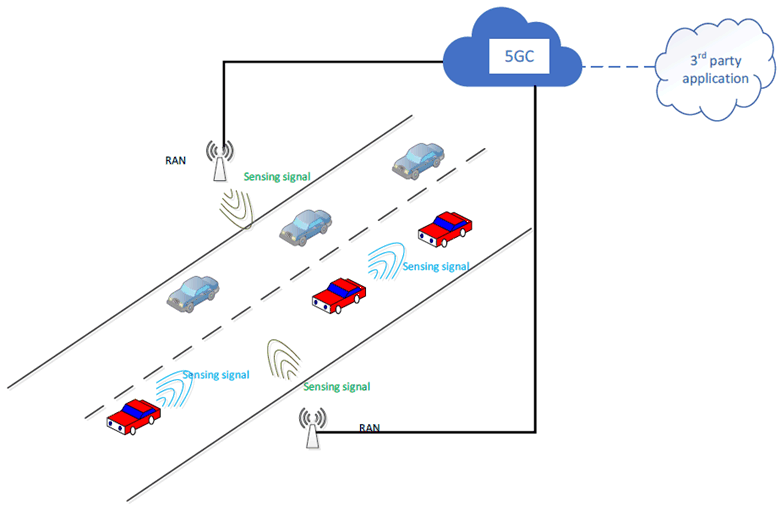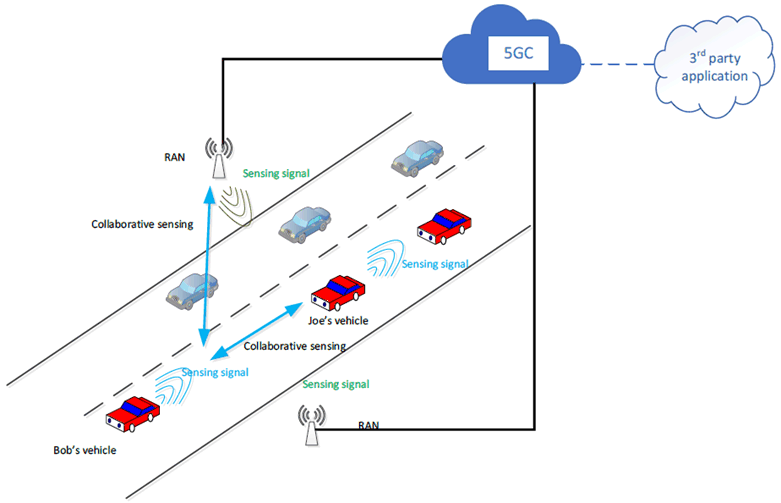Content for TR 22.837 Word version: 19.3.0
0…
4
5…
5.2…
5.3…
5.4…
5.5…
5.6…
5.7…
5.8…
5.9…
5.10…
5.11…
5.12…
5.13…
5.14…
5.15…
5.16…
5.17…
5.18…
5.19…
5.20…
5.21…
5.22…
5.23…
5.24…
5.25…
5.26…
5.27…
5.28…
5.29…
5.30…
5.31…
5.32…
6…
7…
5.8 Use Case on Sensing Assisted Automotive Maneuvering and Navigation
5.8.1 Description
5.8.2 Pre-conditions
5.8.3 Service Flows
5.8.4 Post-conditions
5.8.5 Existing features partly or fully covering the use case functionality
5.8.6 Potential New Requirements needed to support the use case
...
...
5.8 Use Case on Sensing Assisted Automotive Maneuvering and Navigation p. 30
5.8.1 Description p. 30
To support smart transportation and autonomous driving, more vehicle and devices are equipped with sensing technologies. For example, cameras, Radar, and Lidar systems are the most used sensors by the automotive industry to maintain the perception for autonomous vehicles at various levels of autonomy. Accurate sensing results are crucial to enable the safe and reliable control of the vehicles.
Due to the mounting position of the sensors (e.g., 3GPP based sensors) information collected from a single vehicle's sensors can not be sufficient or accurate enough to satisfy the advanced automotive use cases, e.g., autonomous driving, coordinated maneuver, etc. Therefore, the 5G system could coordinate sensing to get sensing data from various sources and generate sensing results which could be consumed at the vehicle and used for the vehicular control and driver assistance, e.g., feed into the Automated Driving System (ADS) in the car [21]. The 3GPP sensing data collected by the UE can be sent alongside relevant sensing information to other sensing entities (including other vehicles, roadside units, and network) for further processing (if required) before sharing with a third-party application as shown in Figure 5.8.1-1.
The network facilitated NR based sensing described above could significantly improve the sensing reliability and quality, enabling new and advanced automotive use cases.

Figure 5.8.1-1: 5G System Assisted Automotive maneuvering and navigation
(⇒ copy of original 3GPP image)
(⇒ copy of original 3GPP image)
5.8.2 Pre-conditions p. 31
In this use case, Joe and Bob's vehicles are equipped with 3GPP-based sensing technology. Non-3GPP sensors like radar, camera and Lidar sensors could also be available in the vehicles. Additionally, the vehicles are capable of 5G communications, including direct communication with other vehicles, communication with 5G system via RAN entities.
5.8.3 Service Flows p. 31
5G system assisted coordination of sensing service
Step 1 (Network provides configurations and policies): When Bob's car registers for 3GPP sensing service, the network provides policies and configurations to enable UEs take appropriate actions during sensing e.g., obtaining 3GPP sensing data from another UEs/RAN entities. For example, the policies provided by network could provide guidance for the discovery UEs/RAN entities with appropriate NR RF sensing capabilities, when to trigger requests, when to stop sending requests, messaging formats, the communication configurations (such as which 5G communication mode to use and under which conditions), the sensing configurations (such as which role i.e. transmitter/receiver, to use by a particular node for a particular sensing task, etc.. These polices and configurations could be updated frequently by the network based on e.g., network conditions, mobility pattern, etc.
Step 2 (Bob determines his sensors are blocked): Bob's sensor(s) is(are) blocked by Joe's vehicle, and cannot adequately detect its surroundings (e.g., detect if there is another vehicle in front). This could result in the vehicle miscalculating the needed distance to stop before a traffic light. In other cases, Joe's vehicle could also reduce the valid sensing region and result in misdetection of incoming vehicles size or shape, especially near intersections. The sensing results cannot fully satisfy the autonomous driving needs and requirement.
Step 3 (Bob recognizes need for sensing inputs): Due to unsatisfactory autonomous driving needs and requirements, the UE in Bob's vehicle is notified that its sensors are blocked and needs 5G System assistance for coordination of the sensing service.
Step 4 (Bob's vehicle discovers Joe's vehicle): With the policies and configurations provided by the 5G system, Bob's vehicle can search for neighbouring UEs/RAN entities or ask the network to provide recommendations for UEs/RAN entities (e.g. considering the current network conditions in the target sensing area) and their 3GPP NR RF sensing capabilities (e.g., if UE/RAN entity supports sensing service). This information would be used to discover other vehicles and RAN entities with 3GPP NR RF sensors that can support sensing in the area. In this example, Bob's vehicle discovered Joe's vehicle could be useful in providing sensing inputs.
Step 5 (Bob's vehicle connects to Joe's vehicle): Bob's vehicle then establishes 5G communication connection with Joe's vehicle and/or RAN entities as shown in Figure 5.8.3-1. The most suitable 5G communication mode (e.g., broadcast, unicast, etc) is determined by the Bob's vehicle based on 5G system configuration and policies.
Step 6 (Bob's vehicle requests sensing info from Joe's vehicle): The request could indicate the information needed to perform sensing, e.g., the additional region to be covered, additional sensing target, synchronization info, etc.
Step 7 (Joe sends sensing results/3GPP sensing data to Bob's vehicle): Based on the information provided by Bob's vehicle; Joe sends Bob 3GPP sensing data identifying objects in its surroundings. It is important to note that when 3GPP sensing data is shared between Joe and Bob, it is expected to be performed in compliance with operator policy on the use of the operator resources (e.g., licensed/unlicensed spectrum).
Step 8a (Bob processes 3GPP sensing data locally): Based on the fact that Bob's has non-3GPP sensors (e.g., camera, Lidar), Bob's car can combine the 3GPP sensing data from Joe's vehicle with other sensors.
Step 8b (The 5G System expose sensing results to third-party application): Additionally or alternatively Bob can share sensing results and non-3GPP sensing data from the camera and Lidar within the 5G System and then it is exposed by the 5G System to a third-party application server for combination by the third-party. It is important to note that contextual information is information forwarded alongside the sensing results which provide context to the conditions under which the sensing results were derived. This contextual information can be used in scenarios where the sensing result is to be combined with data from other sources. It should also be noted that in case contextual information is required, this information should be shared with the appropriate consent, permissions and subject to operator policy.

Figure 5.8.3-1: 5G system assisted automotive maneuvering and navigation
(⇒ copy of original 3GPP image)
(⇒ copy of original 3GPP image)
With the sensing information provided by Joe's vehicle and the network, Bob's vehicle obtains a full map of the region. The autonomous driving algorithm can make corresponding decisions reliably.
5.8.4 Post-conditions p. 33
Using 5G system assistance, Bob's vehicle would be able to achieve highly reliable navigation capacity, by coordinating the operation with other vehicles to collaborate with other sensing devices to improve quality. With high-quality sensing results, advanced smart transportation use cases and autonomous driving could be achieved.
5.8.5 Existing features partly or fully covering the use case functionality p. 33
V2X communication supports the information exchange among the vehicles, between vehicle and infrastructure or network.
5.8.6 Potential New Requirements needed to support the use case p. 33
[PR 5.8.6-1]
The 5G system shall be able to support mechanisms to control UEs and RAN entities for a sensing service.
[PR 5.8.6-2]
For a sensing service, the 5G system shall be able to support mechanisms for the UEs and RAN entities to provide 3GPP sensing data.
[PR 5.8.6-3]
The 5G system shall be able to support an authorized UE in the discovery of UEs and selection of RAN entities with the required 3GPP NR RF sensing capabilities for the sensing service.
[PR 5.8.6-4]
Subject to user consent and regulations, based on operator policy, the 5G system shall be able to provide means to authorize and configure a UE for sensing operation (e.g., based on location, time, etc) and for establishing the communication connection needed to assist the sensing service.
[PR 5.8.6-5]
Subject to user consent and regulations, based on operator policy, the 5G system shall be able to support exposure of sensing results and sensing contextual information (e.g. UE location), to a trusted third-party application.
[PR 5.8.6-6]
The 5G system shall be able to provide means for the 5G network to activate and/or deactivate sensing service in the target sensing area based on network conditions (e.g., network-load).